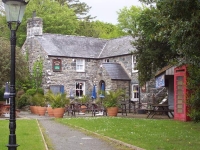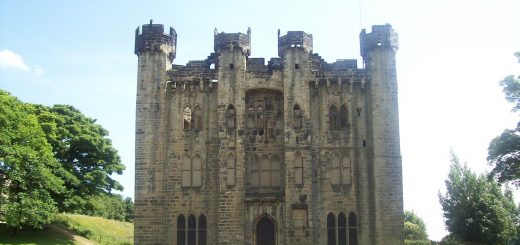Neidpath Castle
Neidpath Castle is one of the stronger positioned Peel Towers or fortified Tower Houses that are dotted around the border lands, testimony to the troublesome period of Border skirmishing and lawlessness in the 14th-17th Century. The castle sits on a firm defensive position surmounting a rocky crag overlooking the River Tweed.
![Vinckie [CC BY-SA 4.0 (https://creativecommons.org/licenses/by-sa/4.0)], from Wikimedia Commons](http://www.mysteriousbritain.co.uk/wp/wp-content/uploads/2018/12/Neidpath_Castle_2-300x225.jpg) Essentially the castle is an L plan Tower House constructed of 3 barrel vaulted stories, subdivided in 5 levels in all. The castle consisted of a lower section used for storage, incorporating a pit prison, a first floor consisting of the Great Hall and kitchens and an upper story that was further divided for habitation. Evidence of its defensive structure can be observed in the ten feet thick walls and few small windows, proving a solid bulwark against attack with the added advantage of good strategic location.
Essentially the castle is an L plan Tower House constructed of 3 barrel vaulted stories, subdivided in 5 levels in all. The castle consisted of a lower section used for storage, incorporating a pit prison, a first floor consisting of the Great Hall and kitchens and an upper story that was further divided for habitation. Evidence of its defensive structure can be observed in the ten feet thick walls and few small windows, proving a solid bulwark against attack with the added advantage of good strategic location.
There was an earlier castle on this site owned by the Fraser family, and probably built by Sir Simon Fraser Sheriff of Tweedale in the 1360’s. Sir Simon had an adventurous life as a Knight fighting for both Edward I and William Wallace/Robert the Bruce for Scotland’s Independence. He was captured by the English at the battle of Dunbar in 1296, and agreed to fight for Edward in France. His lands were restored in Tweedale but he then joined the battle for independence gaining notable victories until his defeat at Happrew in 1303. He was captured after the battle of Methven fighting for Robert the Bruce. As was the grim justice of the day Sir Robert was hung drawn and quartered, and like Wallace before him his head was placed on a spike on London Bridge.
Simon’s daughter married a Hay of Yester and the castle passed in to the Hayes family, who rebuilt the castle in the late 14th Century, from when the present structure dates. The castles structure remained fairly constant until the 17th C when the interior was redesigned adding to the work that had taken place in the late 16th C in the upper section of the castle. Mary Queen of Scots is reputed to have stayed at the castle in 1563, and the castle was besieged by Cromwell’s forces in 1650, surrendering under heavy cannon fire (although sources about the siege differ). The castle was sold to the Duke of Queensberry in 1686 passing down the family line until the 3rd Earl of March let the castle out to tenants from 1778. The castle belongs to the Earl of Wemyss.
Traditions and Legends
According to Tradition the Castle is haunted by lady in a brown dress with a white collar, known as Jean Douglas, the ‘Maid of Neidpath’. She is reputed to be the spectre of the daughter of William Douglas, the Earl of March. Jean fell in love with the Laird of Tushielaw but was forbidden to see him by her father. The Laird was sent away while Jean pined away in grief. On the Lairds return he did not recognise Jean in her wasted state, and she is reputed to have died of a broken heart, doomed to wander the castle in sorrow. Sir Walter Scott stayed at the castle and wrote a poem about the legend adding to its popularity.




Recent Comments